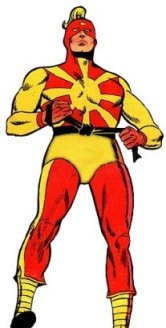
Hercules #8 is in many ways the most peculiar of the run. The issue is dated December 1968 and the cover is by Sam Glanzman. The comic is edited by Sal Gentile.
The lead story is titled "The Boar" and was written by Joe Gill and illustrated by Sam Glanzman. Hercules goes to Hera's agent on Earth King Eurystheus for his next task and is instructed that he must bring back the giant Boar of Mount Erymanthus and return the beast to the court of Eurytheus, and further Hercules is only allowed to use the strength of his own hands to subdue the the monster. Hercules heads off on this task and climbs into the mountains. There he is attacked by giant monster birds with poisonous talons, creations of Hera, but these disappear when Zeus orders her to cease her attack. High in the snowy mountains Hercules comes across an encampment of warriors, one of whom calls him a fool for taking on the Boar. Hercules cuffs the mocker and then heads higher still to seek the Boar, which he is told will be easy since the monster will be hunting him. He finds the tracks but after following them for a while he gets concerned when it appears the beast is circling around behind. Almost immediately the giant Boar attacks and Hercules wrestles it, finally getting atop its back. Sliding up and down the mountainside Hercules rides the Boar bareback for a week until he at last tames the monster. This newly trained creature he rides back to Eurytheus in triumph.
This lead story is shorter than usual coming in at twelve pages.
Next is the letters page "Letters to the Editor -- Hercules". It features two letters, one asking for original artwork. The response indicates either it's policy not to release the originals or there's a legal liability for doing it, the editors seem confused on that point. One letter writer makes note that Dick Giordano is gone on the DC.
"The Legend of Hercules" is a one-shot feature this issue. It's presumably written by Joe Gill and is certainly illustrated by Sam Glanzman. It relates the classic origin of Herucles, telling the story of how he killed serpents in his crib and how he was trained by the centaurs in warcraft. There's a spectacular full-page shot of Herucles in battle alongside Zeus and Hera against the Titans. Also it says that Hercules was on the voyage with Jason and his Argonauts for the Golden Fleece. It is after this that Hercules seeks atonement, but it's unclear why, save that he seems ashamed he's human at all and not a full god. He goes to the Oracle of Delphi who sends him to Eurytheus. The six-page feature concludes with a summary of the previous seven tasks Hercules had performed (Lion of Nemea, Gerion the Giant, Cerebus the Hound of Hades, Apples of Hesperides alongside Atlas, Amazons, Stymphalian Birds, and the Bull of Minos).
Thane of Bagarth is written by Steve Skeates and illustrated by Jim Aparo. This installment is titled "Chapter Eight: Escape". It begins with the alchemist Mordwain administering a drug to Hrothelac to give him strength, which promptly knocks him out. The scene cuts to Beowulf's man Eadstan who leads the Geats agains the Swedes in battle. The battle is brutal and at last Eadstan is struck down, but is found by a Swedish servant girl. Back in England in the dungeon Hrothelac is awake and full of furious energy as he attacks the door to his jail. The guards enter and Hrothelac attacks them escaping. Mordwain escapes too. Hrothelac heads to the shore where another Viking ship approaches. But he collapses and is found by a band of Celtic villagers.
The lead story was reprinted in Charlton Classics #8.

Now Hercules #8 is unique. In addition to the four-color version I've detailed above, there was issued presumably at the same time a magazine-size black and white version of the comic. It's similar but not identical to the color version. It's also dated December 1968. The cover is developed from a panel by Sam Glanzman inside the story, and added is a figure of Hrothelac Thane of Bagarth by Jim Aparo. (This is the only cover appearance by Thane of Bagarth in its orignal run.) The lead story is titled "The Fantastic Giant Boar" and is largely the same story written by Joe Gill and illustrated by Sam Glanzman from the color comic. The story though is reformatted and the twelve page story is expanded to twenty. This is done by blowing up certain panels and suchlike.
The rest of the contents is comprised of reprinted material from early issues of Hercules. Next is the first Thane of Bagarth chapter followed by the first Hercules story from Hercules #1. Then two additional chapters of Thane of Bagarth (Chapters Two and Three) close out the magazine.
I don't really know what Charlton was trying to do here. I presume they were exploring to see if Hercules would sell in other venues using the material they'd developed. 1968 saw Marvel experiment with magazines, specifically the Spectacular Spider-Man books. And of course there was the relatively ongoing success of Warren's line of books. There is not editorial in the magazine to explain it. One small note though is that Sal Gentile is listed as the editor, despite the fact that most of the material in the magazine was produced when Dick Giordano was editor of the line.
I didn't get a copy of this magazine until many years after the fact, though I have a vague recollection of seeing it on stands at the time. It's a curiosity for sure, a real oddball relic from Charlton's oddball history.
More to come.
Rip Off












































